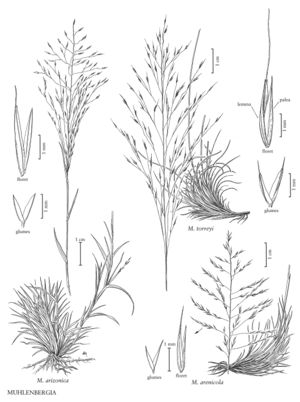Difference between revisions of "Muhlenbergia torreyi"
FNA>Volume Importer |
FNA>Volume Importer |
||
| Line 17: | Line 17: | ||
-->{{Treatment/Body | -->{{Treatment/Body | ||
|distribution=Kans.;Okla.;Colo.;N.Mex.;Tex.;Wyo.;Ariz.;Nev. | |distribution=Kans.;Okla.;Colo.;N.Mex.;Tex.;Wyo.;Ariz.;Nev. | ||
| − | |discussion=<p>Muhlenbergia torreyi grows in desert grasslands and open woodlands on sandy mesas, calcareous rock out-crops, and rocky slopes, at elevations of 1000-2450 m. Its range extends from the southwestern United States to northern Mexico. It also grows, as a disjunct, in northwestern Argentina.</p> | + | |discussion=<p><i>Muhlenbergia torreyi</i> grows in desert grasslands and open woodlands on sandy mesas, calcareous rock out-crops, and rocky slopes, at elevations of 1000-2450 m. Its range extends from the southwestern United States to northern Mexico. It also grows, as a disjunct, in northwestern Argentina.</p> |
|tables= | |tables= | ||
|references= | |references= | ||
| Line 38: | Line 38: | ||
|publication year= | |publication year= | ||
|special status= | |special status= | ||
| − | |source xml=https://jpend@bitbucket.org/aafc-mbb/fna-data-curation.git/src/ | + | |source xml=https://jpend@bitbucket.org/aafc-mbb/fna-data-curation.git/src/8f726806613d60c220dc4493de13607dd3150896/coarse_grained_fna_xml/V25/V25_742.xml |
|subfamily=Poaceae subfam. Chloridoideae | |subfamily=Poaceae subfam. Chloridoideae | ||
|tribe=Poaceae tribe Cynodonteae | |tribe=Poaceae tribe Cynodonteae | ||
Revision as of 16:34, 18 September 2019
Plants perennial; cespitose, not rhizomatous. Culms 10-40(50) cm, decumbent, usually all the nodes concealed by the sheaths; internodes mostly scabrous or smooth, hispidulous below the nodes. Leaves strongly basally concentrated, most blades not reaching more than 1/5 of the plant height; sheaths shorter than the internodes, rounded, not keeled, scabridulous or smooth, not becoming spirally coiled when old; ligules 2-5(7) mm, hyaline, acuminate, lacerate, often with lateral lobes; blades 1-3(5) cm long, 0.3-0.9 mm wide, tightly involute or folded, arcuate, scabridulous, midveins and margins not thickened, green, apices somewhat sharp-pointed. Panicles 7-21 cm long, 3-15 cm wide, diffuse; primary branches 1-8 cm, diverging 30-90° from the rachises, stiff, naked basally; pedicels 1-8 mm, sometimes appressed to the branches. Spikelets 2-3.5 mm. Glumes equal, 1.3-2.5 mm, scabridulous, 1-veined, apices acute to acuminate, minutely erose, unawned or awned, awns to 1.1 mm; lemmas 2-3.2(3.5) mm, narrowly elliptic to lanceolate, appressed-pubescent on the basal 1/2 - 3/4 of the margins and midveins, apices scabrous, acuminate, awned, awns 0.5-4 mm; paleas 2-3.2(3.5) mm, narrowly elliptic, intercostal region sparsely pubescent, apices acuminate; anthers 1.2-2.1 mm, greenish. Caryopses 1.7-2 mm, fusiform, brownish. 2n = 20, 21.
Distribution
Kans., Okla., Colo., N.Mex., Tex., Wyo., Ariz., Nev.
Discussion
Muhlenbergia torreyi grows in desert grasslands and open woodlands on sandy mesas, calcareous rock out-crops, and rocky slopes, at elevations of 1000-2450 m. Its range extends from the southwestern United States to northern Mexico. It also grows, as a disjunct, in northwestern Argentina.
Selected References
None.
